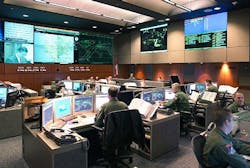DARPA approaches industry for new battlefield network algorithms and network protocols
Officials of the U.S. Defense Advanced Research Projects Agency (DARPA) in Arlington, Va., issued a broad agency announcement on Friday (DARPA-BAA-16-41) for the Dispersed Computing project, which seeks to boost application and network performance of dispersed computing architectures by orders of magnitude with new algorithms and protocol stacks.
Examples of such architectures include network elements, radios, smart phones, or sensors with programmable execution environments; and portable micro-clouds of different form factors.
DARPA will brief industry on the Dispersed Computing project this week in a Webcast from 9:30 to noon eastern time this Thursday, 30 June. Register for the Webcast online at https://www.schafertmd.com/darpa/i2o/dispersedcomputing/pd/index.php?p=webcast.
Today users with significant computing requirements typically have depended on access to large, shared data centers to which they backhaul their images, video, or network log files for processing, DARPA officials explain.
Related: Rugged routers enable the network-centric battlefield
Still, the cost and latency of this backhaul sometimes can cause problems in different operational scenarios -- especially when network throughput is severely limited or when the user application requires a near real-time response.
In these conditions users could benefit from using taskable computing power that available locally. The Dispersed Computing program seeks scalable decision systems that enable secure, collective tasking of computing assets in a mission-aware fashion by users with competing demands, and across large numbers of heterogeneous computing platforms, officials say.
These systems must be able to operate in environments where network connectivity is variable and degraded, and enable users to move code to data, and data to code to suit users, applications, and mission needs best.
The Dispersed Computing program also seeks new kinds of network protocols that avoid drawbacks involved with confining application-layer and transport-layer protocol logic to the end points that act as sources and sinks of the data. Today programmable, secure high-speed information processing within the network now is technically feasible.
Related: General Dynamics wins major WIN-T battlefield networking contract to link Army warfighters
These advances warrant a fundamental reconsideration of how to use programmable execution environments located along the path between end-points to boost performance through, such as dynamic modification of protocol logic, or localized in-path analytics to facilitate efficient diagnostics and corrective actions.
The project seeks to create programmable platforms networked computation points (NCPs) that use Dispersed Computing software. An NCP could execute functions in support of user applications, network protocol stacks, or both.
The Dispersed Computing project will consist of three technical areas: algorithms for dispersed mission-aware computation; programmable nodes and protocol stacks; and technology integration.
The first technical area will develop algorithms and control mechanisms to enable efficient use of networked, geographically dispersed, heterogeneous computing capabilities.
These algorithms will benefit users whose tight constraints on latency make interactions with distant data centers difficult, and whose computational complexity may preclude sole reliance on the user’s end device. In such cases using computing power from nearby networked computation points may enhance user performance.
New algorithms also could help with processing sensor data when users are limited to nearby computers to reduce the need for high-volume backhaul of unprocessed information to distant data centers.
Algorithms must be able to rank the importance of available computer resources among competing tasks and users. Systems should be able to scale to thousands of simultaneous users and computing locations.
The second technical area, programmable nodes and protocol stacks, seeks to develop programmable protocol logic within the network -- primarily at the transport and application layers of the five-layer protocol stack model.
These may include new functions on user devices that interact with networked computation points to optimize overall performance, such as localized probing, measurement, and analytics for network diagnostics; on-the-fly synthesis of protocol logic; dynamic modifications of NCP platform resource allocation; or adaptive packet or flow manipulation at NCPs.
Companies interested should submit proposals no later than 7 Sept. 2016 to the DARPA BAA Website at https://baa.darpa.mil/. Several company may win phase-one contracts.
Email questions or concerns to Stuart Wagner, the DARPA Dispersed Computing program manager, at [email protected].
More information is online at https://www.fbo.gov/spg/ODA/DARPA/CMO/DARPA-BAA-16-41/listing.html.
